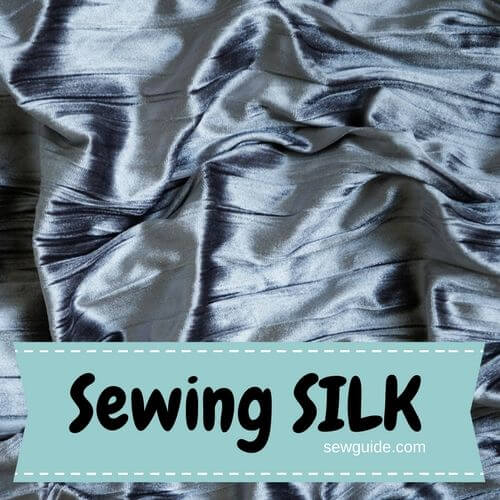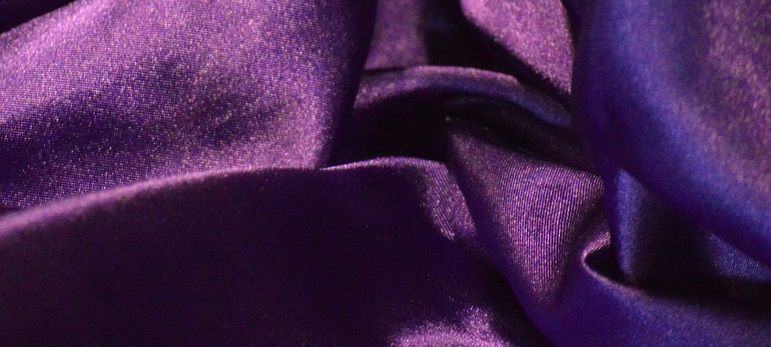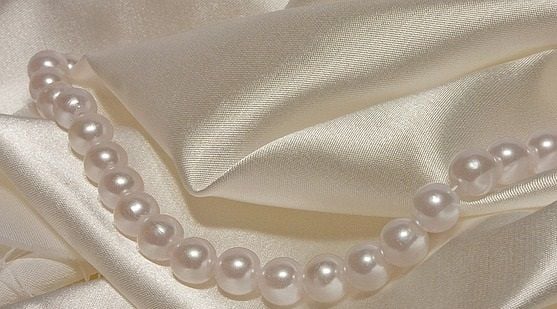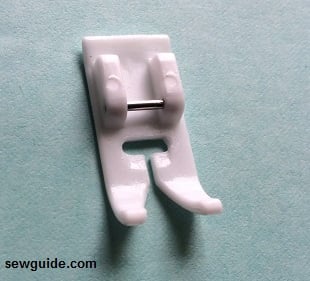Silk is a gorgeous fabric but sometimes you stop considering it so, when you start sewing with it. The uneven cut edges, thread snags, the needle plate eating the fabric, wavy edges, pins leaving holes, uneven unattractive hems. This beautiful fabric can soon become your most dreaded fabric for sewing.

Recently I was sewing a traditional dress for my daughter for a school function. You will know what pressure is, when you sew for finicky young girls and that too the night before you want it done, without extra fabric to make a spare.
I had all the problems you can imagine with sewing silk and had some sort of feeling in my chest which I googled and found it is called palpitation.
I could have saved a lot of those ‘palpitations’ by taking some precautions. If the following problems are sorted out, this out-of-this-world fabric can still be the most wonderous fabric you can ever find to make your clothes from
Tips for Sewing silk successfully
What I would do differently next time when sewing silk

Problem 1. Are all silks the same?
There are different levels of thickness/handle in silk fabrics. You have to recognise this first before starting any sewing. For example silk charmeuse is a lightweight silk and will call for a different way to sew than a heavy silk like silk dupioni. China silk is a slippery silk and you have to careful when sewing this. Silk velvet is also very fluid and slippery. Silk organza is lightweight and sheer. Silk crepe de china is a beautiful textured silk which is also great for dressmaking. It is also fluid and drapey.
The most favourite silk fabrics for dressmaking are silk dupioni, silk habotai, silk chiffon, silk georgette, silk charmeuse and silk organza. Check out all about the different types of silk fabrics
Problem 2. How do I prepare the silk fabric for sewing?
Every sewing tutorial says to prewash all fabric before sewing them. So what to do about dry clean only silk?. Well, silk also needs to be prewashed.
Dry clean the fabric like you would the final garment. If you are would like a diy remedy to dry cleaning use a baby shampoo and hand wash in cool water (test a small piece first). Check out the post on washing and caring for silk.
Then lay it out flat to dry without wringing it. Just before it is completely dry use a medium hot iron to press out the wrinkles. (Use a press cloth to press) Now your silk is ready to be cut and sewn. Prewash lining material as well if you intend to use it.
But for that beautiful finishing, you find in store-bought silk clothes, do not prewash. But when calculating yardage as well as fit, expect as much as 3% shrinkage.
Problem 3. The fabric slips when I cut or it is an uneven mess
I would use the sharpest scissors I can get. Then I would take long cuts.If it is a small pattern piece interfacing would give it some weight as you cut
Lay silk in a single layer and that too on a surface which is not slippery- a cotton fabric surface would do. I would not cut the silk fabric in many layers unless I am a pro. I would cut only single layers. Make the patterns so, not on the fold. When I try to cut two layers or more of slippery silk the down layers always shifts and cuts differently than the first.
For cutting big silk pattern pieces, if the silk is thin, I would put paper under it while cutting to give some weight. Some suggest sandwiching silk fabric between papers and I found it a very good idea. Just pin along the very edges to keep them in place.
One problem with this method is that the paper may dull the scissors – well, when one problem goes away another pops up.You can always sharpen the scissors pronto
Some silk fabrics have a very soft very delicate surface (like silk charmeuse); The surface can get snagged and damaged if they are not washed properly. Treat these fabrics delicately.
Problem 4. Basting the silk fabric creates pin marks
Use very sharp thin pins for silks (reserve them for delicate smooth fabrics so they never dull). This will prevent the pin marks and thread snags on silk
If possible I would never pin the fabric in visible areas ie I would pin only on the seam allowance.
Problem 5. My beautiful fabric has stains after sewing with it
A wipe of the sewing machine before sewing silk is necessary to make sure that there are no lint or sewing machine oil or dirt. This way your precious fabric is not stained. Keep your hands clean and dry as well. If you have sweaty hands keep a towel ready at hand
Water also leaves spots on silk. You will have to use a dry cloth on the back of the silk fabric and top it with a slightly wet pressing cloth before pressing silk – this will ensure that you get only enough water on silk, not too much to leave water spots.

Problem 6. What thread and sewing machine needle should I use to sew silk?
Which thread to use with silk? – I would use a polyester thread or cotton thread or a poly cotton thread depending on the type of silk fabrics. For 100% silk I would use cotton thread, because they are almost of same strength. You can also use cotton embroidery thread. A polyester thread may cause puckers.But for blended silk I will use the polyester thread or cotton poly thread as this is slightly tougher.
As for needles, use thin Microtex needles (Sharps) in size 60/8, 65/9 for thin silk; size 70/10 for medium weight silk. Microtex needles are Fine needles with a slim sharp point. You can use universal needles with medium weight silks.
Hand sewing of silk can be done with silk thread or hand embroidery thread. Use thin needles for hand sewing (size 10)
If I am attaching sequins or beads I would definitely interface the area behind. The thin delicate fabric will start to come apart due to the added strain.
Problem 7. Sewing seams on silk – Stitch length etc.
For sewing seams on thin delicate silk you may test a stitch length of 1.5 – 2; For me 1.5 was good for thin silk. But for thicker silks like silk dupioni use the regular stitch length of 2 or 2.5.
If you have cut silk on the bias or you have a stretchy silk on your hands use a very narrow zigzag stitch – stitch length 2 and 1.5 width
Instead of back stitching when you start sewing reduce the stitch length to 0 and stitch and then increase the stitch length
Use a straight stitching presser foot with straight stitch needle plate for straight stitching instead of the universal presser foot.
Problem 8. The presser foot doesn’t move on silk
I would use a teflon foot or plastic presser foot for sewing silk; this seems to do the trick for me for this kind of slippery fabrics

Another method is to increase the tension a little ( Sometimes this maynot work as increased tension can cause puckering)
Problem 9. The needle plate sucks the silk fabric inside as I sew
Use a straight stitch needle plate for regular seam stitching; unless you want the zig-zag stitch.
Another way is to interface silk fabric on the seam line ; you can keep tissue paper on top or underneath as you stitch and remove after stitching is done.
Keep a hold on to fabric as you sew; Hold the thread ( both top thread and the bobbin thread) to the back as you start to sew.
Problem 10. Unraveling of fabric edges makes the inside look messy
The question is “How do you keep silk from fraying?” – You should always finish the inside of the dress as much as the outside for a professional finish to your homemade garments. Check out the 15 dressmaking tips that can change the look of your handmade clothes
Silk frays a lot. If it is sheer and the seam is visible from the outside use a french seam. Check out the post on the french seam for more details.
A serged finish or a zig zag stitched finish is used for regular seams. If you are more finicky about the finish on the inside you can try a bound finish for the edges. Use bias strips of the silk fabric for binding the seam allowance. The inside will look as good as the outside just like they do on couture clothes.
You can add twill tape if you want added strength to the seam allowance.
Problem 11. What interfacing and lining should I use with silk
Interfacing should be Lighter than the fabric or of the sae weight. The self-same fabric (the same fabric for the garment) is the best interfacing you can use with delicate silk; it will behave as if you are not using one at all , but will give all the advantage of using one. You can also use cotton batiste (prewashed) if you have a medium weight silk fabric like silk dupioni.
If you want a crisp feel use silk organza as the interfacing. Silk organza is strong yet sheer. Polyester organza also can give you a needed stiffness.
When using fusible interfacing you cannot use the regular one you use with other fabric for thin silk fabrics. It will look puckered. Check if the store where you buy sewing supplies have silk weight interfacing. You can use Acrylic backing for sewing upholstery or even better a knit backing. For some projects in home decor you can even use paper as a backing.
As for lining cotton batiste or silk organza are the popular choices for silk garments.
Problem 12. I am confused as to what hem to use on my silk garment
Wide hems need to be treated very carefully. Do hand basting and then a stretchy blind hem ( hand sewn is preferred) will work.
A narrow hem is easier like a rolled hem. Use the hemmer foot for this.
Problem 13. Best way to finish neckline and armholes
You can bind the edges (neckline edge /armhole edge if sleeveless) with bias binding tape instead of using facing.
Problem 14. I have water spots on the silk
You would have used a spray starch or even the steam on your iron. Silk stains easily. I would dampen a cloth and go over the fabric to be ironed all over with it, and then iron. This is better than spraying with steam.
Problem 15. How do I press silk without damaging it?
100% silk can take some heat but if you have a blended silk be very careful with the heat.Test before you apply hot iron on silk.
One problem with silk is you get a shiny look when pressed directly with iron. Iron from the wrong side or use a pressing cloth and your silk fabric will be alright.
Related posts: Silk fabric care- tips; Basic fabric and garment care. ; How is silk made?; Quality guidelines to know if you have real silk ; Silk vs Satin

This was extremely helpful since my nephew gave me day project of sewing his silk ties into a quilt. I have had many questions answered by this article. Thamks!
The best trick I have found for sewing silk:
– Before cutting out your silk, mix 1/2 cup of water with 1 tablespoon of a washable white glue (like Elmer’s School Glue). If the mix has lumps, let it sit in a jar overnight.
– After cutting and marking the silk, lay each piece flat and use a small artist’s paintbrush to paint a thin line of the glue mix on the raw edge. (Wipe down your work surface with a damp cloth between pieces.) This keeps fraying under control while you are sewing!
– After the garment is finished, soak it in cold water for 10 minutes, then hand-wash.
– I don’t know if dry cleaning will remove the glue mix, because I only work with silk that has been hand-washed. Test a swatch of your fabric, of course.
Thank you Mary
Please could you make suggestions as to which fabric would be suitable for lining a silk crepe-de-chine full skirt, so that the fabrics do not stick together ?
Hi Maureen,
Have you thought of using Silk crepe de chine itself as it is usually used as a lining fabric, as it is lightweight and not very expensive like other silk. All other lightweight silks used for lining are slinky and may stick to skin. Rayon crepe is another option. Check out this post on lining fabrics
Getting confused and need advice about making a memory pillow from a limited supply of neckties. Some are polyester, more are silk, and I will need to use both. Seeking recommendations about thread, interfacing, and base fabric (will use sew/flip method for piecing).
Hi Marcie
I would use a new needle on my sewing machine, and sew with polyester thread. Polyester remains the same but silk shrinks when washed so you may have puckering problem because of this – dry cleaning instead of wet cleaning can solve this, I think. You will be using a backing fabric underneath the ties, so you can match the interfacing to suit this. My thoughts. Best wishes.
Great tips!
I am constructing a table cover using India silk material from older drapes. Does the cover need to be lined and should I use batiste or organza?
Hi Sarina.
Did you ever try using a rotary cutter and a self-healing cutting mat to cut the silk instead of using scissors? That would solve your problems.
I always use a rotary cutter on a self-healing mat. Works great.
I am trying to at fringe to silk twill 14mm, but the minute I pull the needle out there is a vertical or horizontal line that shows up in the weave, it looks like a pulled thread. Do you happen to know how I can avoid that?
Hi Mona
Is it that you have a needle that is not sharp or it has a chip which creates the cloth to snag. Maybe you should attach interfacing on the back or keep a paper in the back as you stitch.
can you teach me how to sew a silk blouse with lining with a cotton lining meterial
Hi sarina madamme,
can you please teach how to sew silk blouse with a cotton lining cloth with measurements.
I don’t want to disagree…
The fabric pictured and some of the problems solved seem like synthetic fabric, not silk. As a natural fiber, silk fabric is pretty easy to work with as long as you treat it like what it is- silk. It’s not a “delicate” wrt washing as long as you use soap, not detergent, and never use bleach. Silk is strong when wet so iron or manipulate it damp. (rayon is weak when wet)
If it says to dry clean either the dyes are unstable- do a test with a scrap of fabric- or they lie- do a test with a scrap of fabric. Some people suggest pre-washing and “converting” it to a washable fabric. I’ve done that and been satisfied with the results.
The best silk resource is “The Silk Workers Notebook”. Unless someone studies the chemistry and mechanics of fibers specifically it’s unlikely they’ll access that level of knowledge of silk elsewhere. It’s an excellent read.
Hi Kate
Thanks for your input. Wetting silk and manipulating it never occurred to me.
True. Thanks a lot for this.
Thank you for all the information you have given me, it was so helpful to me.
Hi Valerie
Glad I was able to help you. Thanks for the comment